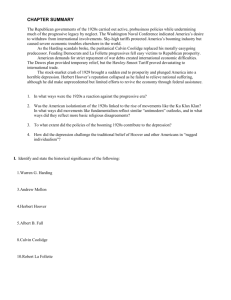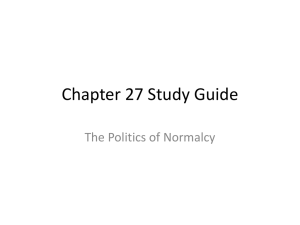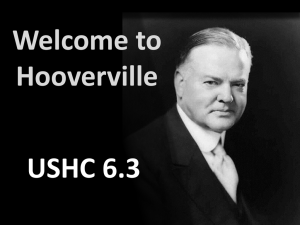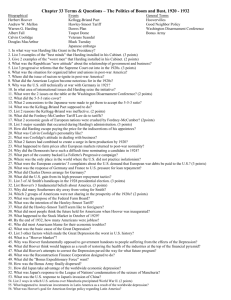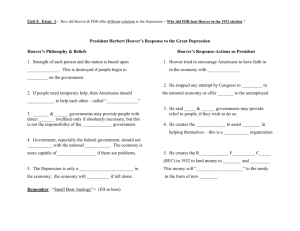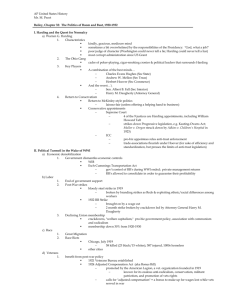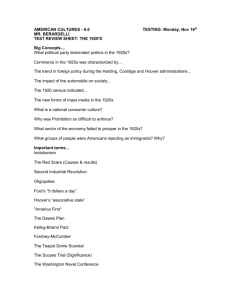The Politics of Boom & Bust
advertisement
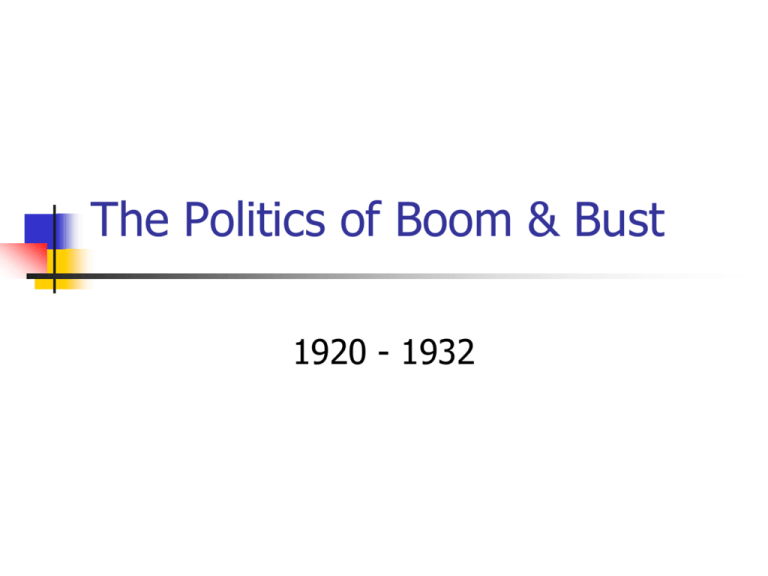
The Politics of Boom & Bust 1920 - 1932 President Harding’s Ohio Gang Cabinet Members: - “The Ohio Gang” Sec of State – Charles Evans Hughes Sec of Treasury – Andrew Mellon Sec of Commerce – Herbert Hoover Sec of Interior – Albert Fall Attorney General – Harry Daugherty Harding as President “Old Guard” hoped to improve on the old business doctrine of laissez-faire Gov’t should help guide business along the path to profits Put a end to a lot of progressive legislation Supreme Court - Taft as Chief Justice Adkins v. Children’s Hospital - reversed Muller v. Oregon No different treatment for women in the workplace Antitrust laws were ignored The Aftermath of War War Industries Board disappeared Railroads returned to private management in 1920 Esch-Cummins Transportation Act of 1920 Merchant Marine Act of 1920 – get rid of wartime fleet Union membership declined by 30% American Legion founded Lobbied for veterans’ benefits – Bonus Army Adjusted Compensation Act – 1924 Paid-up insurance policy America Seeks Benefits Without Burdens July 1921 – joint resolution officially ending the war Isolationism but concerned about oil in the Middle East Sec Hughes eventually secured rights for US oil companies Washington Disarmament Conference – 1921-1922 Agenda – naval disarmament & situation in the Far East (Japan) Five-Power Naval Treaty of 1922 Included ship ratios, US & Great Britain could not fortify their Far Eastern possessions & replaced the Anglo-Japanese alliance Nine-Power Treaty of 1922 Open Door in China was extended Kellogg-Briand Pact 1927 - Aristide Briand (France) proposed a treaty with the US to outlaw war Frank Kellogg (US) invited other nations to join Paris – Aug 1928 – almost all major nations signed the treaty Outlawed aggression, not self-defense, & had no enforcement provision Hiking the Tariff Higher Mellon sought substantial increases in protective tariffs Fordney–McCumber Tariff Law – 1922 Increased tariff to 38.5% Duties on farm produce were increased President could raise or lower rates to a limit of 50% on recommendation of the Tariff Commission Harding & Coolidge favored increased tariffs Hurt not only America but also European countries as well Scandal 1923 – Charles Forbes – Head of the Veterans’ Bureau Caught stealing money - $200 million// Sentenced to 2 years 1921 - Teapot Dome Scandal Albert Fall - Sec of Navy transferred valuable properties to the Interior Dept (with Harding’s approval) Teapot Dome, Wyoming & Elk Hills, CA Fall leased the lands to oilmen Harry Sinclair & Edward Dohney after receiving a bribe Fall was found guilty of accepting a bribe & sentenced to one year Scandal Conti. 1924 - Attorney General Daughtery Investigated for illegal sale of pardons & liquor permits Forced to resign & later released after 2 juries failed to agree Harding went on a speechmaking tour across the country including Alaska Aug 2, 1923 – died in CA Coolidge takes office Calvin Coolidge “Silent Cal” Honest Supported the status quo “the man who builds a factory builds a temple” “the man who works there worships there” Frustrated Farmers Farmers were being hurt by overproduction Coolidge twice refused to sign legislation which proposed to subsidize farm prices Capper-Volstead Act – exempted farmers’ from antitrust legislation McNary-Haugen Bill – 1924 – 1928 Goal was to keep farm prices high by authorizing the gov’t to buy up surpluses & sell them abroad – farmers would pay a special tax Election of 1924 Republican – Calvin Coolidge Democrat – John W. Davis Progressive – “Fighting Bob” La Follette Platform gov’t ownership of the railroads Relief for farmers Anti-monopoly & anti-labor injunctions Limit Supreme Court’s power to invalidate laws of Congress **** Coolidge Wins Coolidge’s Foreign Policy Isolationism Pursued further disarmament Armed intervention in the Caribbean & Central America US troops removed from Dominican Republic (1924) US troops remained in Haiti 1914 – 1934 Removed troops from Nicaragua (1909) but sent them back in 1926 – 1933 Mexico (1926) – oil dispute International Debt US Treasury had loaned the Allies $10 billion US demanded repayment Allies planned to pay off debt by reparations received from Germany Germany could not pay Allies wanted the debt to be forgiven US refused Dawes Plan of 1924 Rescheduled German reparations payments & opened the way for further American private loans to Germany US bankers loaned Germany money Germany paid Great Britain & France reparations Great Britain & France paid US Treasury for war debts The Triumph of Hoover 1928 Coolidge decided not to seek reelection Republican – Herbert Hoover Democrat – Alfred E. Smith Never held an office before “wet” Roman Catholic Radio – helped Hoover more than Smith Hoover was the 1st Republican to win any Southern states President Hoover Stocks continued to soar Left out of the boom: Unorganized wage earners & disorganized farmers Agricultural Marketing Act – 1929 Designed to help farmers help themselves through cooperatives Set up a Federal Farm Board Lent money to farm organizations seeking to buy, sell, or store surpluses Created the Grain Stabilization Corporation & the Cotton Stabilization Corporation Goal was to buy up surpluses to increase prices Hawley – Smoot Tariff of 1930 Increased the tariff from 38.5% to 60% Highest protective tariff in peacetime history Infuriated European countries Plunged US & other nations deeper into depression The Great Crash Hoover tried to curb speculation through the Federal Reserve Board October 1929 – Stock Market Crash Unsuccessful Partially triggered by British who raised their interest rates to bring back capital lured by American investments “Black Tuesday” Oct 29, 1929 Millions of shares of stock were sold By the end of 1929, stockholders had lost $40 billion Beginning of the Great Depression Depression hit at home & abroad 1930 – more than 4 million US workers were unemployed 2 years later, the number had tripled Workers who did not lose their jobs took dramatic pay cuts Over 5000 banks collapsed in the 1st 3 years Bread lines formed, soup kitchens dispensed food, & apple peddlers tried to make ends meet Life savings of tens of thousands went with them Birth rate declined Causes of the Great Depression Overproduction by farm & factory Unbalanced Economy Credit Crisis Too much money was going into the hands of a few people Installment buying overstimulated production International Depression Hastened by Hawley-Smoot Tariff of 1930 Hoover & the Depression “Hoovervilles” & “Hoover blankets” Tried to encouraged the public Encouraged local gov’ts to help their citizens Assisted railroads, banks, & rural credit corporations “Trickle Down Theory” Opposed direct help to the people Pioneer of the New Deal Public works – Congress approved $2.25 billion Hoover Dam Opposed all schemes he deemed “socialistic” Muscle Shoals Bill – opposed by Hoover 1932 – Reconstruction Finance Corporation (RFC) Became a gov’t lending bank to business & gov’t 1932 – Norris-La Guardia Act Outlawed antiunion contracts & legalized peaceful strikes, boycotts, & picketing The Bonus Army Veterans were demanding their pay now The “Bonus Expeditionary Force” went to Washington in the Summer of 1932 Federal troops were used to put down the protest Set up “Hoovervilles” Under Gen. Douglas MacArthur Authorized brutal force Caused severe damage to Hoover’s public image Japan Attacks China Sept 1931 – Japan invaded Manchuria. Why? Geneva Meeting – League of Nations US sat unofficially on the council Nothing was accomplished Japan left the League 1932 – Stimson Doctrine Stopped foreign trade with conquered area Violation of the League of Nations covenant US would not recognize any territorial acquisitions that were achieved by force Japan also bombed Shanghai Informal boycotts were launched in the US Hoover Pioneers the Good Neighbor Policy
